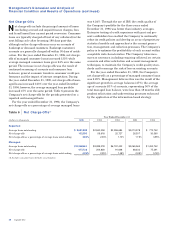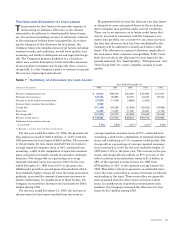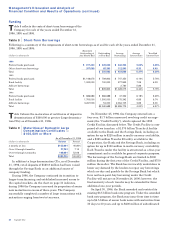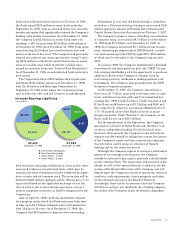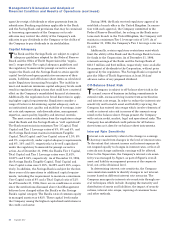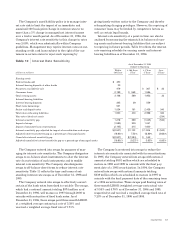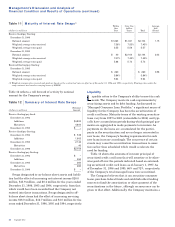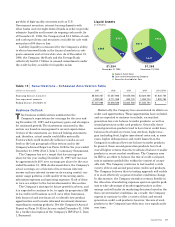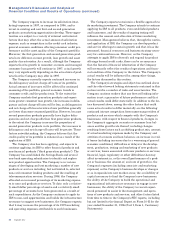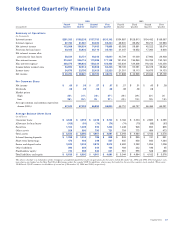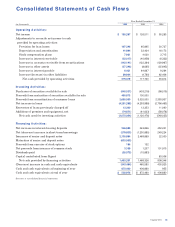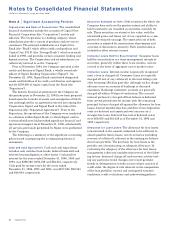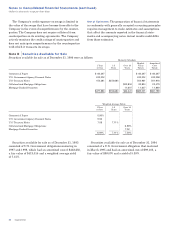Capital One 1996 Annual Report Download - page 38
Download and view the complete annual report
Please find page 38 of the 1996 Capital One annual report below. You can navigate through the pages in the report by either clicking on the pages listed below, or by using the keyword search tool below to find specific information within the annual report.Capital One
Management’s Discussion and Analysis of
Financial Condition and Results of Operations (continued)
36
The Company expects to increase its solicitation (mar-
keting) expenses in 1997, as compared to 1996, and to
invest in existing and new first and second generation
products as marketing opportunities develop. These oppor-
tunities are subject to a variety of external and internal
factors that may affect the actual amount of solicitation
expense, such as competition in the credit card industry,
general economic conditions affecting consumer credit per-
formance and the asset quality of the Company’s portfolio.
Moreover, the first generation and second generation prod-
ucts have different account growth, loan growth and asset
quality characteristics. As a result, although the Company
expects that its growth in consumer accounts and managed
consumer loan growth will continue in 1997, actual growth
may vary significantly depending on the actual mix of prod-
ucts that the Company may offer in 1997.
The Company currently expects continued increases in
the delinquency and net charge-off rates of its portfolio.
Actual amount of increases will be affected by continued
seasoning of the portfolio, general economic trends in
consumer credit and the product mix. To the extent the
Company markets first generation products and experi-
ences greater consumer loan growth, the increases in delin-
quency and net charge-off rates will be less, as delinquencies
and net charge-off characteristics of new portfolios generally
are lower than more seasoned portfolios. However, because
second generation products generally have higher delin-
quencies and net charge-offs than first generation products,
to the extent the Company increases the proportion of
second generation products in its portfolio, the increases in
delinquency and net charge-off rates will be greater. These
factors notwithstanding, the Company believes that the
credit quality of its portfolio is enhanced as a result of the
application of IBS.
The Company also has been applying, and expects to
continue applying, its IBS to other financial products and
non-financial products (“third generation products”). The
Company has established the Savings Bank and several
non-bank operating subsidiaries to identify and explore
new product opportunities. The Company is in various
stages of developing and test marketing a number of new
products or services including, but not limited to, selected
non-card consumer lending products and the reselling of
telecommunication services. During 1996, the Company
allocated an increased percentage of its marketing expens-
es to non-card products or services. To date, only a relative-
ly small dollar percentage of assets and a relatively small
percentage of accounts have been generated as a result of
such expenditures. As the Company continues to apply its
IBS to non-card opportunities and builds the infrastructure
necessary to support new businesses, the Company expects
that it may increase the percentage of its 1997 marketing
and operating expenses attributable to such businesses.
The Company expects to maintain a flexible approach to
its marketing investment. The Company intends to continue
applying its IBS to all products, even established products
and businesses, and the results of ongoing testing will
influence the amount and allocation of future marketing
investment. Management believes that, through the contin-
ued application of IBS, the Company can develop product
and service offerings to sustain growth and that it has the
personnel, financial resources and business strategy neces-
sary for continued success. However, as the Company
attempts to apply IBS to diversify and expand its product
offerings beyond credit cards, there can be no assurance
that the historical financial information of the Company
will necessarily reflect the results of operations and finan-
cial condition of the Company in the future. The Company’s
actual results will be influenced by, among other things,
the factors discussed in this section.
The Company’s strategies and objectives outlined above
and the other forward looking statements contained in this
section involve a number of risks and uncertainties. The
Company cautions readers that any forward looking infor-
mation is not a guarantee of future performance and that
actual results could differ materially. In addition to the fac-
tors discussed above, among the other factors that could
cause actual results to differ materially are the following:
continued intense competition from numerous providers of
products and services which compete with the Company’s
businesses; with respect to financial products, changes in
the Company’s aggregate accounts or consumer loan bal-
ances and the growth rate thereof, including changes
resulting from factors such as shifting product mix, amount
of actual marketing expenses made by the Company and
attrition of accounts and loan balances; an increase in cred-
it losses (including increases due to a worsening of general
economic conditions); difficulties or delays in the develop-
ment, production, testing and marketing of new products
or services; losses associated with new products or services;
financial, legal, regulatory or other difficulties that may
affect investment in, or the overall performance of a prod-
uct or business; the amount of, and rate of growth in, the
Company’s expenses (including associate and marketing
expenses) as the Company’s business develops or changes
or as it expands into new market areas; the availability of
capital necessary to fund the Company’s new businesses;
the ability of the Company to build the operational and
organizational infrastructure necessary to engage in new
businesses; the ability of the Company to recruit experi-
enced personnel to assist in the management and opera-
tions of new products and services; and other factors listed
from time to time in the Company’s SEC reports, including
but not limited to the Annual Report on Form 10-K for the
year ended December 31, 1996 (Part I, Item 1, Cautionary
Statements).




